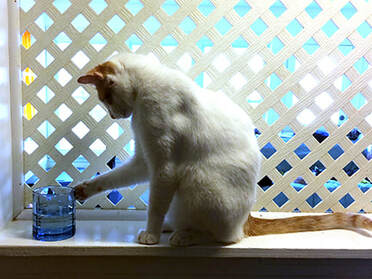
The obvious answer to every cat owner’s question is simple: It’s fun.
Not only that, but the higher the places are the better. And yet, as amusing as it may seem – at first – this behavior can be both annoying and dangerous.
Extremely adept at using their paws when they play, cats will bat at and paw at some objects and by twisting their paws slightly, hook others and toss them into the air. Exceedingly curious and endlessly attracted to rapid movement, they are expert “fly catchers” and acrobats, even turning somersaults in the air as they try to catch the feather at the end of a fishing-pole toy.
From tables and desks to bookshelves and mantles, a cat’s joy at knocking things over may, according to some animal behaviorists, be attributed to several factors, including play-related and exploratory behaviors. Consider this: A cat paws at an object to see if it moves or how it moves and inadvertently knocks it off a desk. Once she sees the object fall, she may be attracted to its speed, the sound it makes hitting the floor or even the attention she receives from her owner.
Why the latter? Because whatever hits the floor elicits an immediate response as the owner seeks out the source of the sound. Some clever cats have learned to capture their owner’s attention in precisely this way: the louder the noise, the faster their owner’s response time. For others, simply watching the object fall and chasing after it on the floor is reward enough. But if that object is glass, she can injure her paws when she jumps to the floor and either lands on or walks through the glass shards.
To stop this behavior from disrupting your household while keeping your kitty safe, don’t leave any objects light enough to be batted around and knocked over on any surfaces accessible to her. This is especially true of fragile or irreplaceable items. If the problem is limited to a single room, try closing the door and keeping kitty out. If that’s not feasible, one option is to apply double-sided sticky tape to the surface(s) in question. When your cat jumps onto a table, e.g., her paws will stick slightly to the tape and the unpleasant sensation should deter her from jumping onto it again. But the most successful solution lies in your preventing her from jumping onto the table in the first place.
What does this entail? If you find your cat on the table, instead of shouting at her or chasing her away, make a noise to get her attention and redirect her to a more appropriate behavior such as chasing after a toy or a laser dot. You can also use clicker training to teach her tricks, thereby keeping her mentally engaged and out of trouble. Another way to redirect your cat’s attention is to give her a “job.” Use multiple puzzle toys and have her “work” for some of her food, while remembering that cats in the wild may spend between 40 and 60 percent of their time actually hunting for food.
If, however, none of these techniques work, speak to your veterinarian who may refer you to an animal behavior specialist.









 RSS Feed
RSS Feed